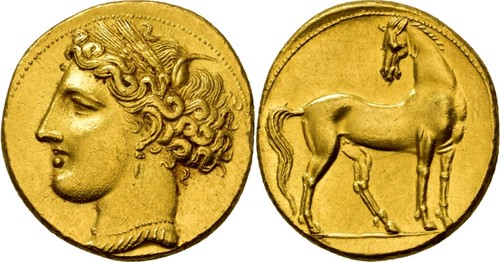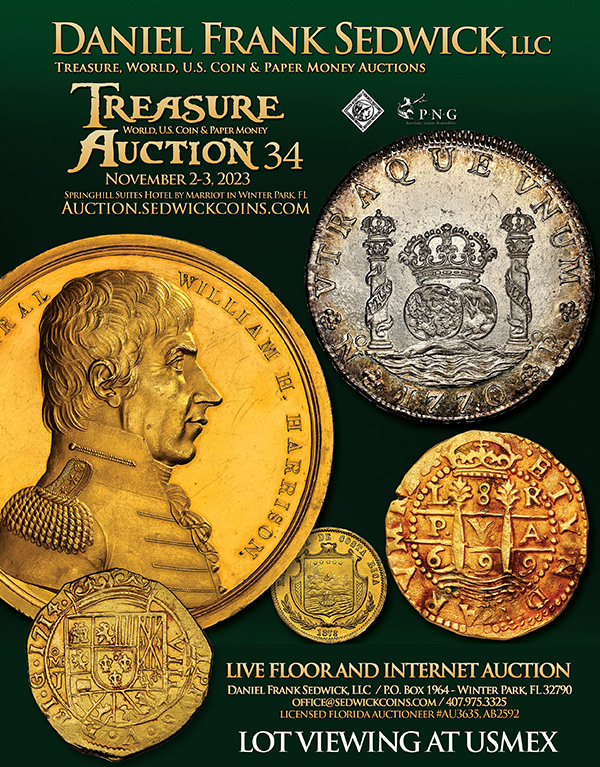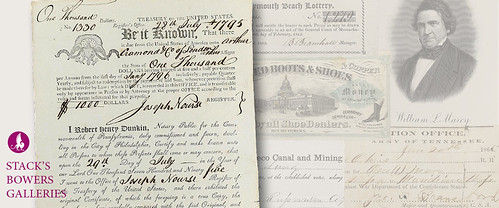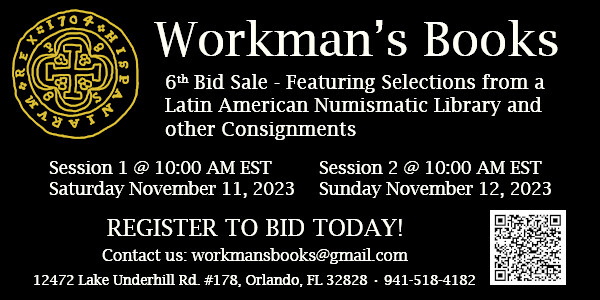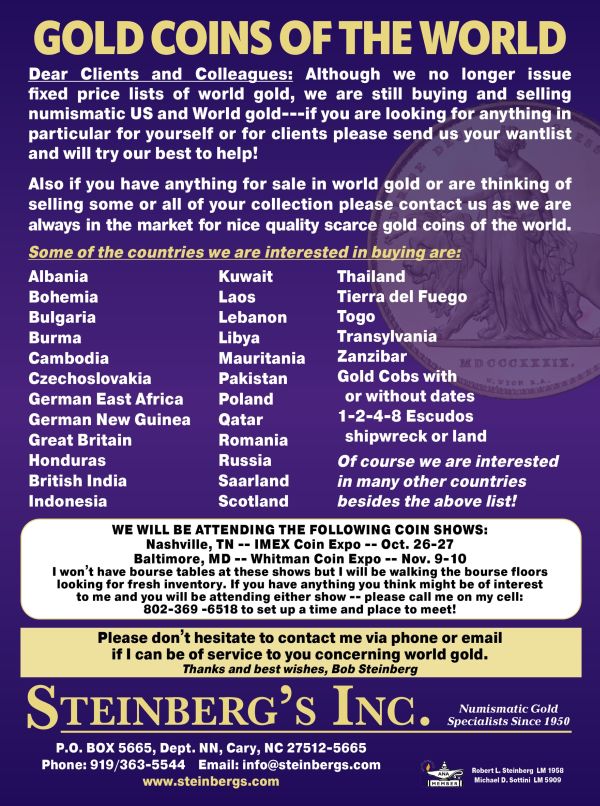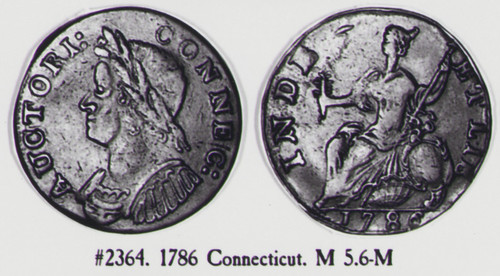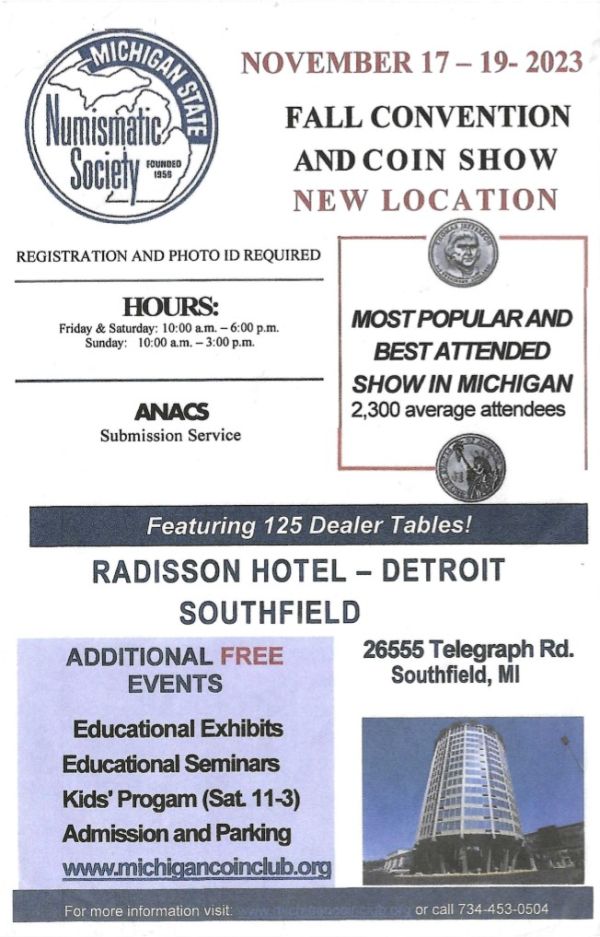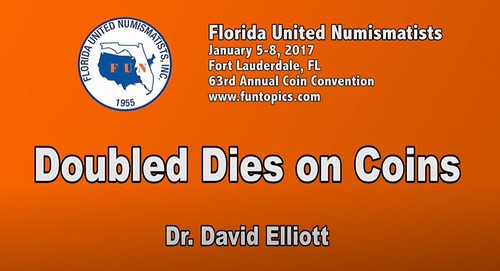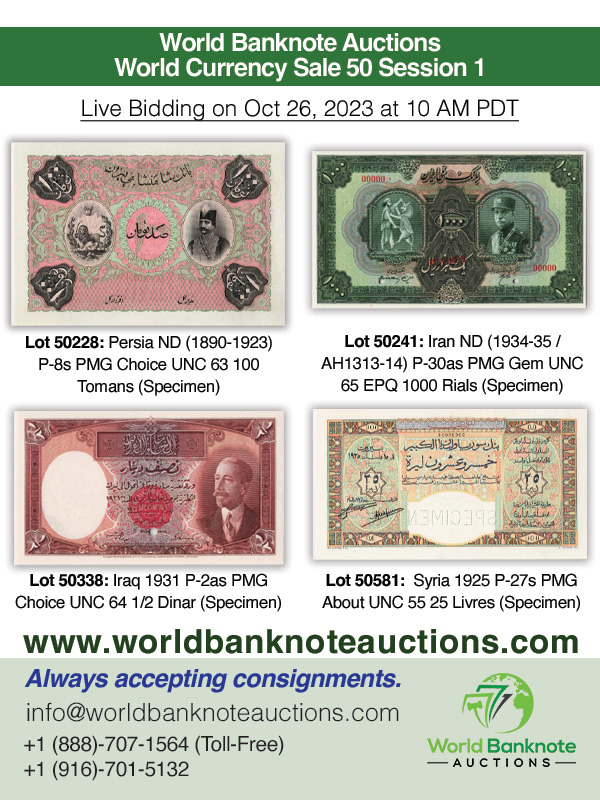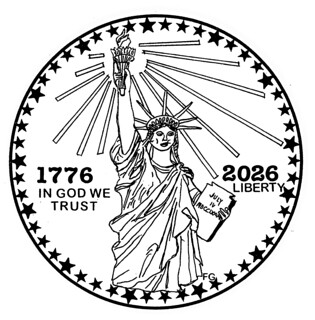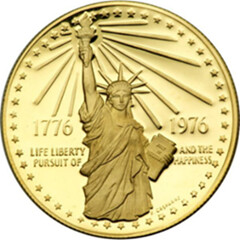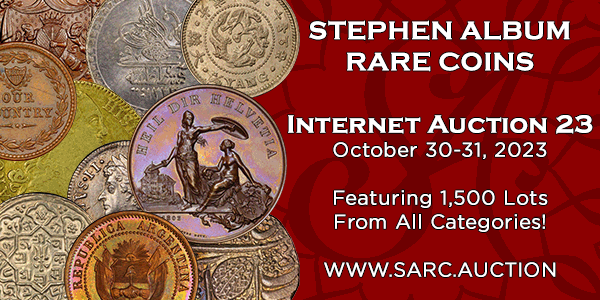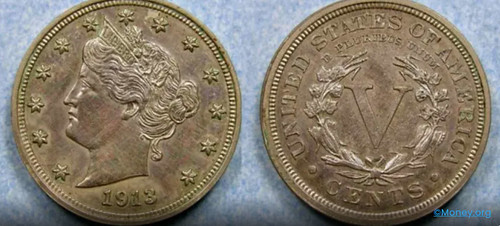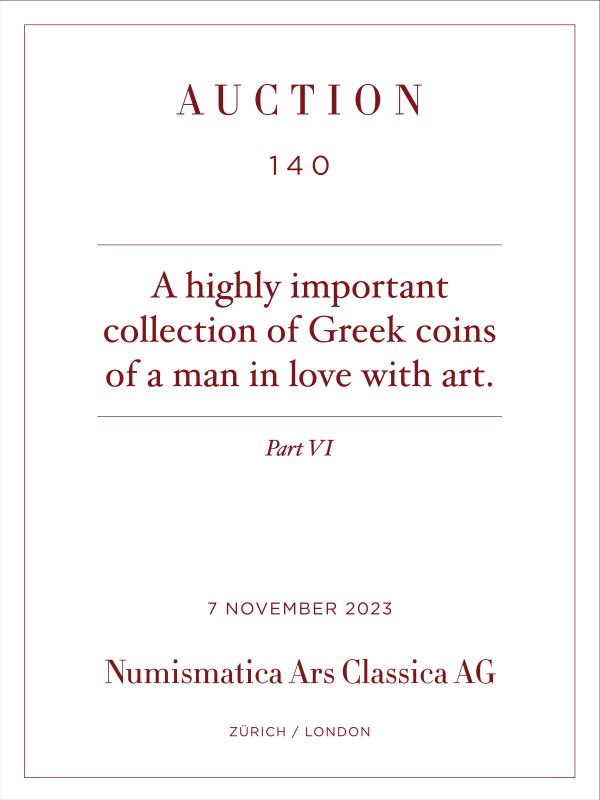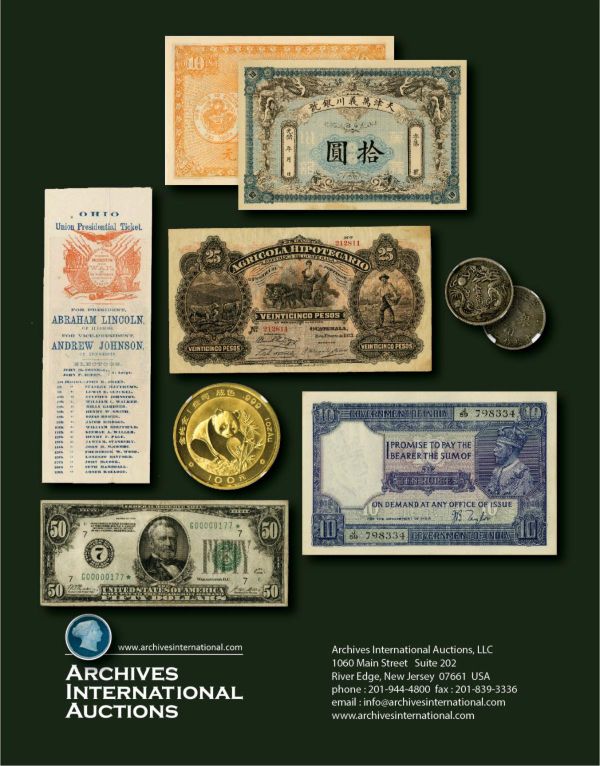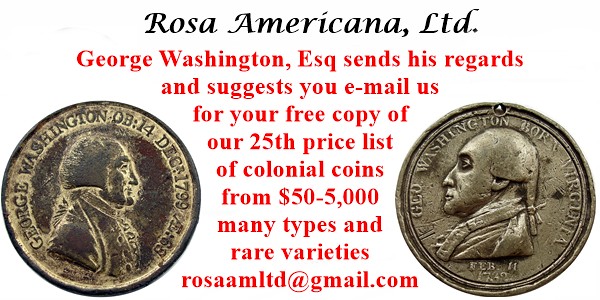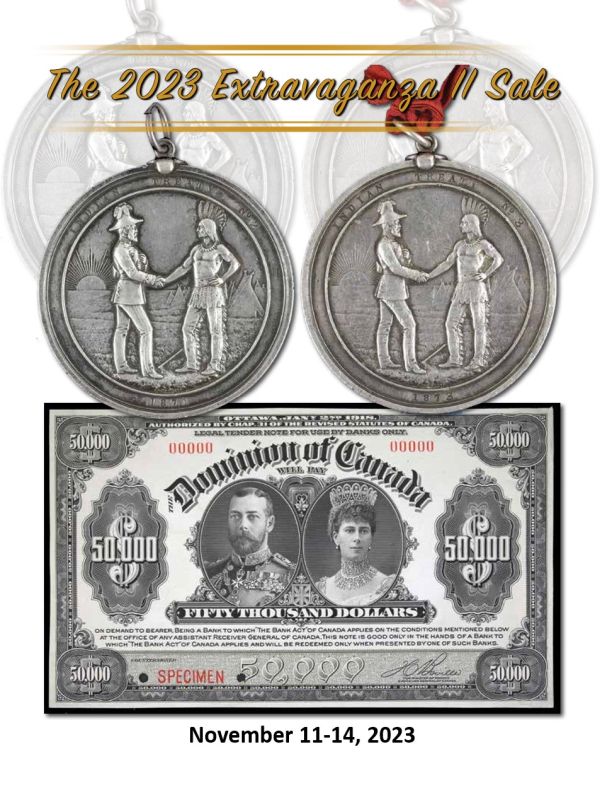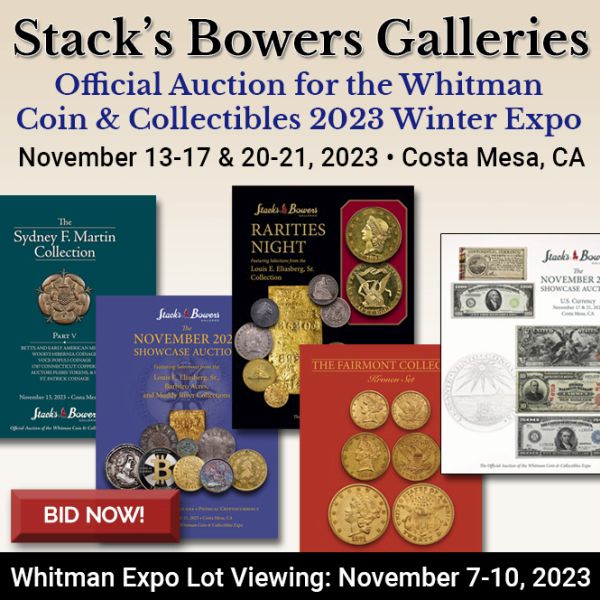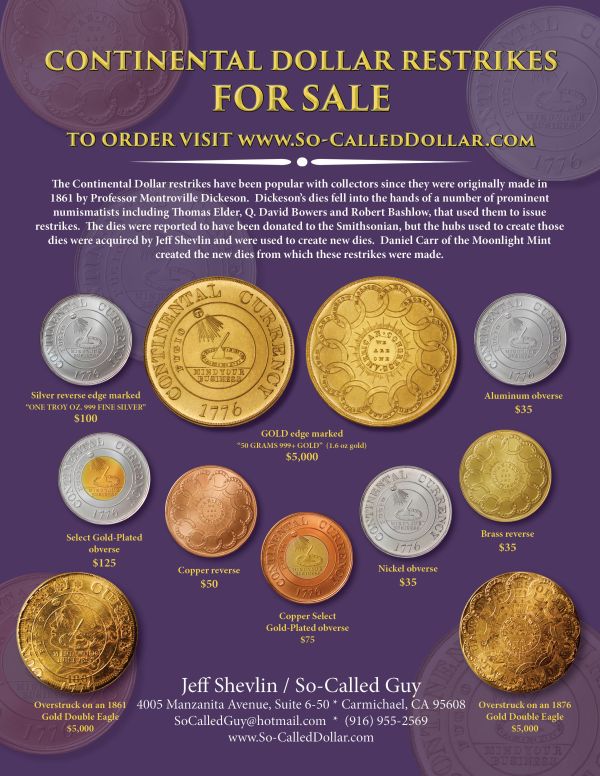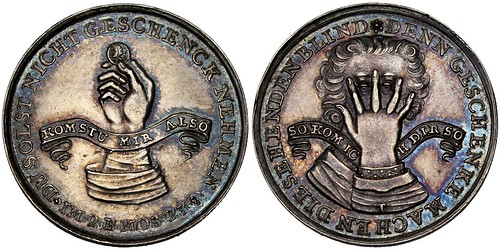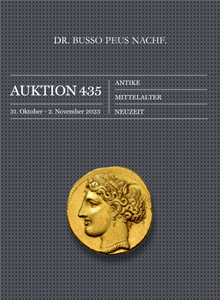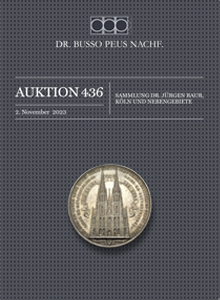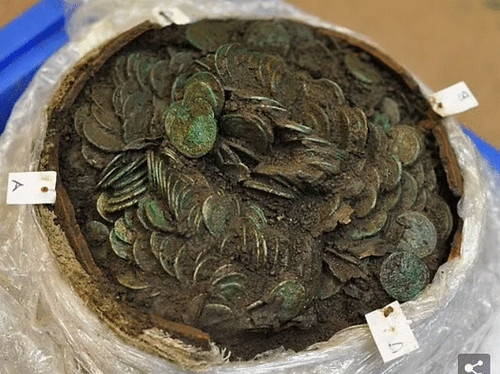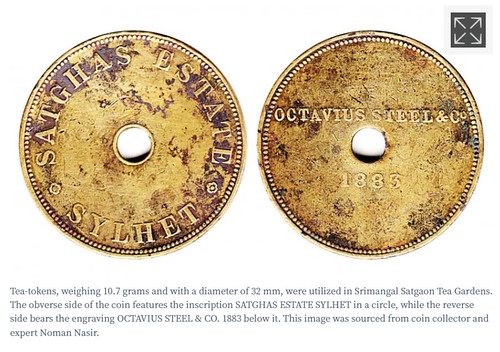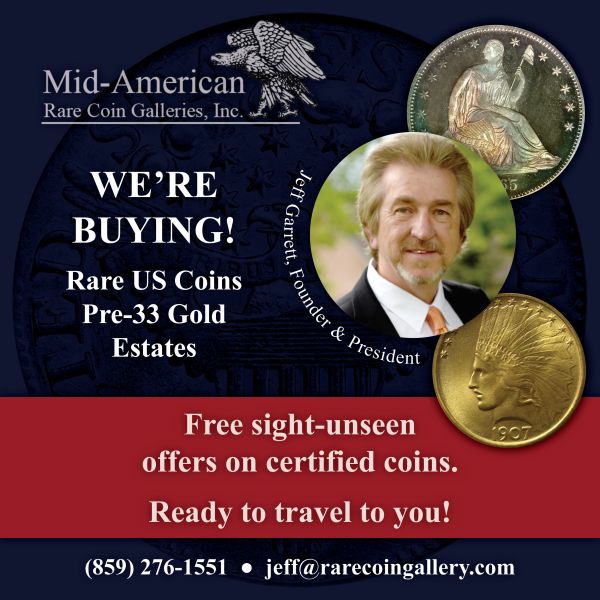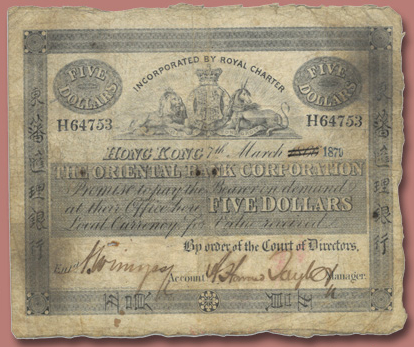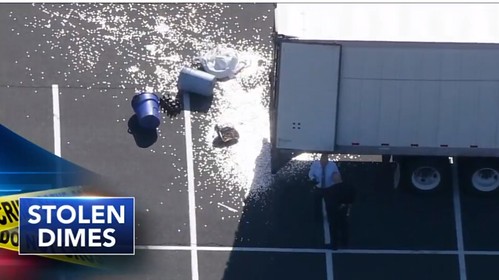
Visit our NBS Sponsors




About UsThe Numismatic Bibliomania Society is a non-profit association devoted to the study and enjoyment of numismatic literature. For more information please see our web site at coinbooks.org SubscriptionsThose wishing to become new E-Sylum subscribers (or wishing to Unsubscribe) can go to the following web page link MembershipThere is a membership application available on the web site Membership Application To join, print the application and return it with your check to the address printed on the application. Print/Digital membership is $40 to addresses in the U.S., and $60 elsewhere. A digital-only membership is available for $25. For those without web access, write to: Jeff Dickerson, Treasurer AsylumFor Asylum mailing address changes and other membership questions, contact Jeff at this email address: treasurer@coinbooks.org SubmissionsTo submit items for publication in The E-Sylum, write to the Editor at this address: whomren@gmail.com BUY THE BOOK BEFORE THE COINSale Calendar |
- WAYNE'S WORDS: THE E-SYLUM OCTOBER 22, 2023
- THE LONG AND THE SHORT OF E-SYLUM EMAILS
- WORKMAN BOOKS SALE 6 SELECTIONS
- 1795 $1000 U.S. TREASURY BOND OFFERED
- NEW BOOK: MEDIEVAL MONEY
- NEW BOOK: MODERN WORLD COINS, 15TH EDITION
- NEW BOOK: NUMISMATICS OF THE BORDERLAND
- NEWMAN PORTAL SCANS TAYLOR PLATES
- VIDEO: DOUBLED DIES ON COINS
- THE VAN WART ANDRE CAPTURED MEDAL
- NOTES FROM E-SYLUM READERS: OCTOBER 22, 2023
- SEMIQUINCENTENNIAL DOLLAR DESIGN IDEAS
- AI-GENERATED NUMISMATIC CRAPOLA
- BUYER BEWARE: FAKE COINS AND BULLION
- EXHIBIT: MEDIEVAL MONEY AT THE MORGAN
- VOCABULARY TERM: OPENWORK
- THE 1952 LAVERE REDFIELD BURGLARY
- RON GILLIO INTERVIEW, PART THREE
- NUMISMAGRAM MEDAL SELECTIONS: OCTOBER 22, 2023
- ARCHIVES INTERNATIONAL AUCTION 88
- DR. BUSSO PEUS FALL 2023 AUCTIONS
- KUENKER AUCTIONS 395-397, PART 2
- NORTH WALES ROMAN COIN FIND
- A NUMISMATIC HISTORY OF NEW ZEALAND
- TEA TOKENS
- 1879 HONG KONG ORIENTAL BANK NOTE OFFERED
- THE MINT'S PRODUCTION MAINTENANCE DIVISION
- PHILADELPHIA DIME HEIST THIEVES CHARGED
Content presented in The E-Sylum is not necessarily researched or independently fact-checked, and views expressed do not necessarily represent those of the Numismatic Bibliomania Society.
WAYNE'S WORDS: THE E-SYLUM OCTOBER 22, 2023
 New subscribers this week include:
Douglas Lang, courtesy Akio Lis, and
Samuel Skokan, courtesy Larry Lee.
Welcome aboard!
New subscribers this week include:
Douglas Lang, courtesy Akio Lis, and
Samuel Skokan, courtesy Larry Lee.
Welcome aboard!
Thank you for reading The E-Sylum. If you enjoy it, please send me the email addresses of friends you think may enjoy it as well and I'll send them a subscription. Contact me at whomren@gmail.com anytime regarding your subscription, or questions, comments or suggestions about our content.
This week we open with an update on E-Sylum email issues, numismatic literature and ephemera sales, three new books, updates from the Newman Numismatic Portal, and more.
Other topics this week include U.S. Treasury bonds, medieval money, numismatics of the borderland, doubled dies, semiquincentennial coin design ideas, openwork, the LeVere Redfield burglary, Ron Gillio, fixed price and auction previews, tea tokens, and the Philadelphia Mint dime thieves.
To learn more about the paper currency issues of the Bank of Spain, Spanish treasure bars, Modern World Coins, the Frederick Taylor colonial coin auction photographic plates, the Van Wart Andre Captured medal, a Dance of Death medal, and New Zealand rarities, read on. Have a great week, everyone!
Wayne Homren
Editor, The E-Sylum
THE BOOK BAZARRE
THE LONG AND THE SHORT OF E-SYLUM EMAILS
Thanks so much for all of your patience and emails as we've worked through some delivery issues with the weekly E-Sylum. While many of you never had issues, users of AOL, Yahoo and some other email providers have experienced problems in recent weeks. These providers were rejecting our emails as spam, which led to follow-on issues causing several subscriptions to be dropped.
As noted earlier, email providers will never tell you exactly why they reject a message (not wanting to tell actual spammers how to get round their rules). But that leaves legitimate senders like us in the dark, having to guess and experiment.
Last Sunday we tried an experiment that worked in a big way - dozens and dozens of readers reported receiving their issue after a multi-week dry spell. What worked was sending a very short email with links to the full issue on our website. We also sent a normal version with all of the content in the body of the email itself. These are actually far smaller than they look because images are not embedded in the message; rather, they are hosted elsewhere on our Flickr archive. But apparently the size of the issue was still triggering the problem for AOL, Yahoo and some others.
So for the time being we'll continue sending our both versions to everyone of the mailing list. Only one will get through to some of you. In time we'll likely switch to the shorter version for everyone.
Here are some of the reader reactions to last Sunday's experiment. The first came from Martin Purdy in Upper Hutt, New Zealand. -Editor
WORKMAN BOOKS SALE 6 SELECTIONS
Alan Workman has a numismatic literature sale closing November 11-12, 2023. Here's some more selected lots. -Editor
Workman's Books is conducting its Sixth sale, "Sale 6 - Selections from A Latin American Numismatic Library and other Consignments.". Accompanying the Latin American Numismatic Library is a sizeable consignment of books, catalogs, magazines, journals, and dealer fixed price lists on numismatics, orders & decorations, militaria, shipwrecks, sunken treasure, lost treasure, treasure hunting, lost mines, and treasure in the American West.
SESSION 1:
- Books: 1 to 467
- Auction Catalogs & Dealer Fixed Pricelists: 468 to 734
SESSION 2:
- Auction Catalogs & Dealer Fixed Pricelists: 735 to 1267
- Journals & Magazines: 1268 to 1345
- Posters: 1346
- Newspapers: Lot 1347
- Photos: 1348 to 1349
- Postcards: 1350 to 1351
- VHS Tapes: 1352 to 1354
- DVDs: 1355
1795 $1000 U.S. TREASURY BOND OFFERED
A Stack's Bowers Galleries blog article by Numismatist Asher Zelson highlights several interesting paper items in their upcoming sales. -Editor
Numismatic-adjacent
material is a personal point of interest for me as a collector, and I relish the opportunity to handle items that fall just beyond the scope of coins, paper money, tokens, and medals. Such ephemera can often have a deep, intriguing history and, under the right circumstances, bring significant premiums due to their obscurity and scarcity. Both the internet-only and live sessions of our November 2023 U.S. Currency Auction feature unique examples of numismatic-related paper ephemera that are sure to pique the interest of paper money and exonumia collectors alike.
NEW BOOK: MEDIEVAL MONEY
A new book accompanies an upcoming exhibit on "Medieval Money, Merchants, and Morality" at the Morgan Library & Museum in New York. See an article elsewhere in this issue for more on the exhibit. -Editor
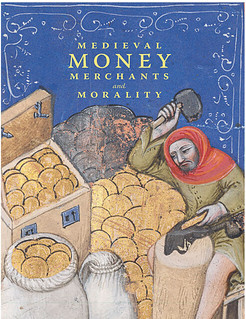 Medieval Money, Merchants, and Morality
Medieval Money, Merchants, and Morality
Diane Wolfthal, with Steven A. Epstein, David Yoon, and Deirdre Jackson
2023
232 pages
8 x 10 inches
Hardcover
$44.95
A vibrantly illustrated, interdisciplinary volume that explores how art reflected and reinforced the complex ethical discussions that developed from the widespread role of money in the Middle Ages
NEW BOOK: MODERN WORLD COINS, 15TH EDITION
Whitman has published a new 15th edition of the classic A Catalog of Modern World Coins, 1850–1964. -Editor
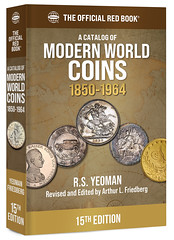 Whitman Publishing announces the release of the 15th edition of A Catalog of Modern World Coins, 1850–1964, by R.S. Yeoman, edited by Arthur L. Friedberg. The 544-page book is available nationwide as of October 2023, in bookstores and online.
Whitman Publishing announces the release of the 15th edition of A Catalog of Modern World Coins, 1850–1964, by R.S. Yeoman, edited by Arthur L. Friedberg. The 544-page book is available nationwide as of October 2023, in bookstores and online.
The revised and edited 15th edition features retail valuations by coin type for 300 nations and states, in up to four grade levels. Editor Arthur Friedberg and his team of experts from around the globe provide an accurate snapshot of the exciting market for more than 11,000 world coins.
The 1st edition of the Catalog of Modern World Coins was published in 1957 (at which time it listed coins from 1850 to 1955). Collectors quickly nicknamed it the Brown Book,
after its cover color—similar to the Red Book,
as author R.S. Yeoman's Guide Book of United States Coins was popularly known.
NEW BOOK: NUMISMATICS OF THE BORDERLAND
Jason Elwell, President of the International Coin Club of El Paso Inc. has published a new book on the numismatics of the U.S. - Mexico border region. Congratulations. Here's the announcement. -Editor
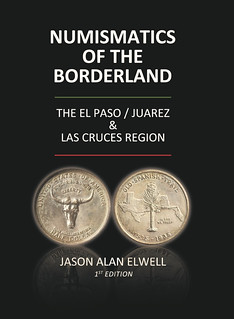 A new book cataloging the numismatics of the U.S. / Mexico border is now available to the public.
A new book cataloging the numismatics of the U.S. / Mexico border is now available to the public. Numismatics of the Borderland: The El Paso / Juarez & Las Cruces Region 1st Edition
by Jason Alan Elwell is a comprehensive literary approach that tells the story of where two countries and three states meet and their shared numismatic history.
Within the 220 pages of this hardback book, over 950 images can be viewed. All numismatic items have unique identification numbers, specifications, and descriptions. All listed items are documented with actual-sized / full-color imagery set in high resolution (unless otherwise noted). Also featured within this book are historical photographs and documents that help the reader better understand the context of borderland numismatics.
NEWMAN PORTAL SCANS TAYLOR PLATES
The latest addition to the Newman Numismatic Portal is an oversize edition of the Frederick Taylor colonial coin auction photographic plates. Project Coordinator Len Augsburger provided the following report. -Editor
Newman Portal Scans Taylor Plates from SNS Library
VIDEO: DOUBLED DIES ON COINS
The David Lisot Video Library on the Newman Numismatic Portal can be found at:
https://nnp.wustl.edu/library/multimediadetail/522852
We highlight one of his videos each week in The E-Sylum. Here's one from 2017 about Doubled Dies on Coins. -Editor
THE VAN WART ANDRE CAPTURED MEDAL
An auction lot description we quoted last week stated that "The Van Wart medal has not been traced into modern times.". As we noted, that's no longer true. To make this more widely known, here's a republication of two articles from July on the topic. -Editor
A rare early U.S. military medal connected to the treason of Benedict Arnold has been donated to the New York State Museum. Thanks to Stephen Searle and Arthur Shippee for passing along this New York Times article. Here's an excerpt - see the complete article online. -Editor
The American militia men were hidden in the bushes having lunch and playing cards when they heard the horse galloping toward them. Springing from their lookout post near Tarrytown, N.Y., they confronted a stranger who was seemingly in a great hurry.
He was Maj. John André, head of British secret intelligence. But on this day, Sept. 23, 1780, he was disguised as a civilian, John Anderson.
Stuffed in André's boot were papers that laid out how to successfully take the American fort at West Point. He had only received the information two days earlier from Benedict Arnold, the commander of the fort, and André now was riding south in the hope of getting back behind the British lines.
NOTES FROM E-SYLUM READERS: OCTOBER 22, 2023
The Economy of British America, 1607-1789
Jeff Rock writes:
"You should include the full title of John McCusker's book to make it easier for people to find - The Economy of British America, 1607-1789. Despite being written by a distinguished professor of history and economics, it is a very approachable book, not dense in theory or language; and with much information that will be new to numismatists (new-mismatists?)."
Thank you! -Editor
To read the earlier E-Sylum article, see:
NOTES FROM E-SYLUM READERS: OCTOBER 15, 2023 : Review: The Economy of Colonial America
(https://www.coinbooks.org/v26/esylum_v26n42a13.html)
Other topics this week include dealer ethics, British Celtic Coins, and the Fort Davis Military Outpost token. -Editor
THE BOOK BAZARRE
a dazzling memoir by the world's most venerated rare-manuscript dealer and document collector. Every page of this adventure book sparkles with wisdom. A must read!Order your copy online (including at Whitman.com ), or call 1-800-546-2995.
SEMIQUINCENTENNIAL DOLLAR DESIGN IDEAS
Wayne Pearson submitted these design ideas for dollar coins commemorating the 2026 semiquincentennial of U.S. independence. Thanks - what do people think? What other concepts would you suggest? -Editor
DOLLARS.—The Secretary may, in addition to the coins produced under subsections (r) and (w), mint for issuance during the one-year period beginning January 1, 2026, $1 dollar coins with designs emblematic of the United States semiquincentennial.
Based on this 1976 Frank Gasparro medal. 13 stars are larger.
AI-GENERATED NUMISMATIC CRAPOLA
In an email with the subject line "Let's hear it for AI," Dick Hanscom writes:
"There is just so much bad information and fiction in this article: "10 American Coins That Were Once Worth Thousands and Are Now Worth Nothing (msn.com)"
"The last sentence says it all:
Editor's note: This article was produced via automated technology and then fine-tuned and verified for accuracy by a member of GOBankingRates' editorial team"
BUYER BEWARE: FAKE COINS AND BULLION
Speaking of fakes, an auction house using weaselly-worded lot descriptions is getting away with selling fake coins and bullion pieces online, according to an article in the New Zealand Herald. Here's an excerpt - see the complete article online. -Editor
A small auction house has been accused of selling fake rare coins and bullions which has drawn the ire of numismatists around the country. However, a tribunal has ruled it can't stop the auction house from selling fakes and that it's up to the buyer to do their due diligence. Jeremy Wilkinson investigates.
Lipscombe Auction House in Nelson sells hundreds of rare coins per year, specimens that would go for thousands if they were genuine.
But some of them aren't real, as one buyer who spent nearly $8000 on various coins and supposedly silver bullions found out.
EXHIBIT: MEDIEVAL MONEY AT THE MORGAN
Arthur Shippee passed along this New York Times article about a new exhibit on money opening November 10th at the Morgan Library and Museum. Here's an excerpt - see the complete article online. An article elsewhere in this issue discusses the accompanying book. -Editor
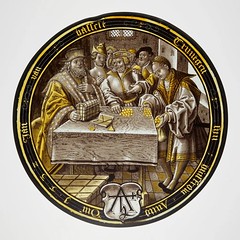 Is it ironic that the Morgan Library and Museum is opening an ambitious exhibition about money in the Middle Ages?
Is it ironic that the Morgan Library and Museum is opening an ambitious exhibition about money in the Middle Ages?
Maybe, maybe not. Suitable
was the word that Deirdre Jackson used. She is the on-site curator of Medieval Money, Merchants, and Morality,
an exhibition that follows the rise of the monetary economy in the late Middle Ages and the early Renaissance, long before J. Pierpont Morgan helped to cement the foundations of modern America's financial infrastructure.
VOCABULARY TERM: OPENWORK
Here's another entry from Dick Johnson's Encyclopedia of Coin and Medal Terminology. I added some images. -Editor
Openwork. A pierced coin or medal, with an opening made as part of its artistic design, or cut out at a later time. Coins are found with square or round holes in the center, with little other openwork design. Openwork medals are somewhat more artistic in that the open area is usually not in the center but appears elsewhere in the design, as part of the artistic expression. All openwork is cut entirely through the item forming the most severe treatment and allowing showthrough with a view of any thing placed behind it.
THE 1952 LAVERE REDFIELD BURGLARY
E-Sylum Feature Writer and American Numismatic Biographies author Pete Smith submitted this article on the 1952 LaVere Redfield burglary. Thanks! -Editor
Everyone knows (or should) about the Redfield hoard of silver dollars. This week I will report on another sensational chapter in his story that got a lot of publicity at the time.
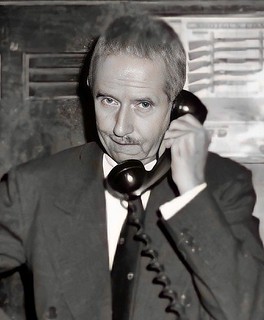 In 1952, LaVere Redfield lived in a fifteen room stone mansion on Mount Rose Street in Reno,
Nevada, with his wife Nell and a Kerry Blue terrier named Mac. They had moved to Nevada in
1935 to take advantage of a state without income tax, corporate tax or inheritance tax.
In 1952, LaVere Redfield lived in a fifteen room stone mansion on Mount Rose Street in Reno,
Nevada, with his wife Nell and a Kerry Blue terrier named Mac. They had moved to Nevada in
1935 to take advantage of a state without income tax, corporate tax or inheritance tax.
Redfield hated the IRS and distrusted banks. He also hated to have his picture taken. He dressed like a common farmer in overalls and a plaid shirt to avoid being recognized as he walked downtown to gamble in the Reno casinos.
Nell and LaVere were away from home when burglars broke into their house around noon on February 29, 1952. They carted off an 18 x 24 x 36 inch green safe that weighed 400-pounds with currency, securities and jewelry initially valued at $2.5 million. Newspapers claimed it was one of the biggest thefts in U. S. history.
RON GILLIO INTERVIEW, PART THREE
Greg Bennick's latest interview for the Newman Numismatic Portal is with longtime dealer Ron Gillio. Here's the third of five parts, where Ron discusses antiques and buying U.S. coins in Europe. -Editor
GREG BENNICK: I like it. So, you mentioned Western Coins and Antiques. I know I brought it up slightly out of sequence before. What could you tell us about Western Coin and Antiques?
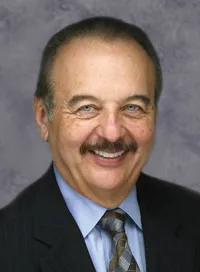 RON GILLIO: Well, I had been going to Santa Barbara for about 10 years before
I opened up in 1971, the store Western Coin Antiques. And it was just a regular coin
store. I mean, it was a regular coin store. I dealt in all facets of coins, coin supplies
for collectors. And then that was kind of the beginning of people investing in coins
and especially in silver. So, I dealt in that. And Santa Barbara is a small town, but
an old town. So, there's a lot of collections that come in my store. And I still travel.
I would go to coin shows almost every other week.
And on Wednesdays, I would go to Coinorama City in Hawthorne, California, which
is a meeting place in the 60s and the 70s. So, it was an interesting business. And I
had some interesting clients that developed into a good business. And I still have the
store in Santa Barbara.
RON GILLIO: Well, I had been going to Santa Barbara for about 10 years before
I opened up in 1971, the store Western Coin Antiques. And it was just a regular coin
store. I mean, it was a regular coin store. I dealt in all facets of coins, coin supplies
for collectors. And then that was kind of the beginning of people investing in coins
and especially in silver. So, I dealt in that. And Santa Barbara is a small town, but
an old town. So, there's a lot of collections that come in my store. And I still travel.
I would go to coin shows almost every other week.
And on Wednesdays, I would go to Coinorama City in Hawthorne, California, which
is a meeting place in the 60s and the 70s. So, it was an interesting business. And I
had some interesting clients that developed into a good business. And I still have the
store in Santa Barbara.
GREG BENNICK: Now, tell me this, the connection with antiques since you haven't brought up Antiques before. Western Coin certainly makes sense. Tell me about your connection to antiques and what was the association there?
NUMISMAGRAM MEDAL SELECTIONS: OCTOBER 22, 2023
Numismagram's Jeremy Bostwick forwarded these five fascinating tokens and medals from his most recent upload of new material to his site. This particular group is very seasonally appropriate, and features numismatic nightmares with rather haunting iconography. For all of the new items, please visit https://www.numismagram.com/inventory. -Editor
102468 | GERMANY. Hamburg. Satirical silver Medal. Issued circa 1708 or slightly thereafter. The supposed corruption of the imperial commission by the Jewish community (23mm, 4.64 g, 6h). By an uncertain medallist, marked "T." DU SOLST NICHT GESCHENCK NEHMEN (thou shalt take no gift...), hand putting forth a coin; across the middle, banner reading KOMSTU MIR ALSO (if you'll scratch my back...) // DENN GESCHENKE MACHEN DIE SEHENDEN BLIND (...for a gift blindeth them that have sight, and perverteth the words of the righteous, –adapted from Exodus 23:8 [2nd Book of Moses]), bust facing slightly right, with hand nearly covering face, though with eyes peering through; t on sleeve; across the middle, banner reading SO KOMME ICH DIR SO (...I'll scratch yours). [The underlined legends are meant to be read as a complete message, while the non-underlined legends are meant to be a separate complete message.] Edge: Reeded. Cf. GPH 1220-1 (different medallist); Brettauer 4796; Fieweger Coll. 345; cf. Vogel Coll. 8739 (gold). PCGS MS-62. Most attractively toned, with some cobalt and violet notes around the devices, and great brilliance remaining. Undoubtedly one of the more alluring examples of the type that one can hope to encounter. Compare to a similar (though highly inferior) example (PCGS AU-53) from a different medalist (Wermuth) that realized a total of $660 in the Stack's Bowers 2021 NYINC auction, lot 23546. $985.
The city of Hamburg had a festering issue between its Senate and Citizens' Council in the late 17th century, with its local Jewish population a chief concern. Though a Sephardic Jewish population had much more long-standing roots in the city, the Ashkenazi population was, in contrast, much more recent and without actual legal status regarding its ability to reside there. The Citizens' Council—dominated by orthodox Protestants—along with the Lutheran clergy sought to block any concessions by the Senate to the Jewish populations, with the issue eventually escalating much higher within the hierarchy of the Holy Roman Empire.
Emperor Joseph I appointed an imperial commission, led by Damian Hugo Philipp von Schönborn-Buchheim, to settle the dispute between the Senate and Citizens' Council in Hamburg. Ultimately, the commission redefined the legal relationships of the Sephardic and Ashkenazi Jewish populations in Hamburg, with the regulations becoming part of the new Hamburg constitution in 1712. It is quite likely that this satirical medal, along with the various others that share a common design and message, were meant to convey the idea that the Jewish citizenry had bribed the commission for recognition of their status, furthering an antisemitic viewpoint among the largely Protestant populace. Given the contemporary works of medallists like Christian Wermuth (who also contributed to this specific "series"), and his satirical issues like the "corn Jew," the concept of antisemitic medals would be completely within the context of the period, and seemingly a likely cause that would generate such a concerted medallic effort among numerous workshops.
To read the complete item description, see:
102468 | GERMANY. Hamburg. Satirical silver Medal.
(https://www.numismagram.com/product-page/102468)
ARCHIVES INTERNATIONAL AUCTION 88
Here is the announcement for the October 24, 2023 sale by Archives International Auctions. -Editor
ARCHIVES INTERNATIONAL AUCTIONS OFFERS HISTORIC U.S., CHINESE & WORLD BANKNOTE & COIN COLLECTION ON OCTOBER 24, 2023.
The auction will be held by Archives International Auctions at their offices in River Edge, N.J.
DR. BUSSO PEUS FALL 2023 AUCTIONS
The auction house Dr. Busso Peus Nachf will offer coins, medals and numismatic literature in sales on October 31st through November 1st. Here's the announcement. -Editor
The autumn auction of the House of Dr. Busso Peus Nachf. extends over three auction days, which are reflected in two auction catalogs.
Day 1, October 31st , traditionally opens with the antiques (488 lots). The distribution of Greek and Roman characters is roughly equal. The majority of the ancient coins can demonstrate solid auction provenance, which in the case of No. 301, an Antoninian of Laelianus, goes back to the Prince Waldeck collection, auctioned in 1935, and in one case (No. 247) even to the 18th century. Among the Greeks
deserve a magnificent tetradrachm of Mithradates VI. from Pontus (No. 110) and the title piece of the catalog, a gold trihemistater from Carthage (No. 177), minted in the middle of the First Punic War, special appreciation. The Roman world is represented with numerous rarities, starting with the provincial coins, where two rarissima (nos. 188, 189) from the Burstein collection, which were auctioned in our house over 20 years ago, next to a magnificent bronze of Cleopatra (no. 192) may be of some interest to connoisseurs. Among the Romans
a pair of gold pieces recorded and depicted as unique in Robert Göbl's corpus of Gallienus is one of the highlights (nos. 292, 293). A solidus of Constantius II from Arelate (No. 317) and one of Magnentius (No. 322) both stand out with their good preservation and great rarity. Finally, the rarely offered Byzantine Emperor Alexander, a particularly desirable piece of gold, is also represented in the last part (No. 361). The antiques section concludes with a wide range of collector-friendly, low-valued lots.
KUENKER AUCTIONS 395-397, PART 2
Künker will hold five auction sales in November. Here's the second part of the press release detailing highlights of sales 395-397. -Editor
Auction 397: Coins from the Ancient World
A journey through the entire ancient world – this experience is made possible by auction 397 on 14 and 15 November. No matter what field you are interested in, auction 397 has something on offer that fits your collection perfectly. Many small and two large collections will be sold. The first one is the Dr. Kurt Conzen Collection, which was mainly acquired in the 1970s and 1980s from major auction houses. The second large ensemble is from the estate of Maître Robert Schuman. It consists of gold coins of excellent quality and covers both Greek as well as Roman and Byzantine gold issues.
A highlight of the sale is a necklace and a bracelet, probably made for Pauline Borghese, Napoleon Bonaparte's little sister. The necklace was among the great showpieces at the then very important Art and Antiques Fair in Delft in June 1966.
NORTH WALES ROMAN COIN FIND
A hoard of Roman coins has been discovered in North Wales. Thanks to Gary Beals and Arthur Shippee for passing this along. -Editor
A pair of novice metal detectorists have discovered a giant Roman hoard of 2,733 coins worth tens of thousands of pounds.
David Moss, 34, and Tom Taylor, 35, found the remarkable haul of 2nd and 3rd century AD silver and copper-alloy coins in a ceramic vessel in a muddy field.
Tom is an avid watcher of Time Team so, with official permission, he and David carefully excavated the pot which was 12ins below the surface before wrapping it in bandages.
A NUMISMATIC HISTORY OF NEW ZEALAND
Joshua Lee submitted this survey article on New Zealand rarities. Thank you. -Editor
In 1840, New Zealand was under the extension of British law upon the signing of the Treaty of Waitangi. As a result, specific provisions from the British Imperial Coinage Act of 1816 were applied to the colony, enabling the standard gold, silver, and bronze coins to be used alongside various foreign coins, all of which were recognised as legal tender in New Zealand.
New Zealand Early Currency
In the mid-1800s, due to a shortage of coins, particularly copper ones, private merchants issued their own penny and half penny, commonly referred to as Tradesman Tokens, which remained in circulation until they were phased out of circulation in the 1880s.
TEA TOKENS
Here's an excerpt from a very nice article on tea tokens from The Daily Star. See the complete article online for more. -Editor
The emergence of tea as a beverage in India is a unique social event in history. Sylhet, Assam, Cachar, Dooars, and Darjeeling were preferred for tea production, considering the hill climate favorable for tea production. These tea regions were known as Surma, Assam, Barak, and Brahmaputra valleys. Tea production began in the middle of the 19th century. At that time, it was unprofitable for the plantation authorities to pay the wages of the workers in the government currency. That's why workers were given tea-tokens as wages.
This facilitated the payment of daily, weekly, or monthly wages to a large group of workers. These not only reduced the hassle of storing large amounts of petty cash but also reduced the financial burden on tea planters. There were tokens of different values, pi, paisa, anna, and then. They were of all shapes and sizes; such as round, oval, triangular, hexagonal, and octagonal.
1879 HONG KONG ORIENTAL BANK NOTE OFFERED
A Stack's Bowers Galleries blog article by Senior Numismatist Dr. Kelvin Cheung, Director (Asia) discusses a rare Hong Kong banknote. -Editor
Stack's, Bowers and Ponterio is proud to present an extraordinary uncancelled 5 Dollar note dated March 7 and issued by The Oriental Bank Corporation. Only four to five notes of this type are known to be extant.
The Bank was original founded in Bombay as the Bank of Western India in 1842. It expanded rapidly in Asia during the 1840s with offices opening in Colombo (1843), Calcutta (1844), Shanghai (1845), Canton (1845), Singapore and Hong Kong (1846). The Bank was renamed Oriental Banking Corporation in 1851 after acquiring a royal charter.
The Bank continued its rapid expansion during the 1850s with offices opening in major cities such as Madras, Yokohama, Foochow, Hiogo, and San Francisco. By the 1860s it became the most powerful, oldest, and most prestigious Eastern exchange bank.
THE MINT'S PRODUCTION MAINTENANCE DIVISION
This article from the U.S. Mint website describes some of the day-to-day work of production maintenance staff. Here's an excerpt - see the complete article online. -Editor
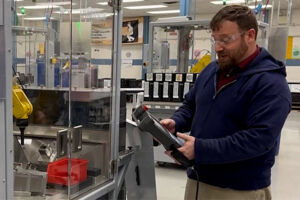 The United States Mint production facilities rely heavily on advanced machinery to make our nation's coins. Whether machines are recent innovations or old favorites, Mint employees' expertise helps keep production on track. Meet some of these skilled technicians and learn how they serve an important role at the U.S. Mint in Philadelphia.
The United States Mint production facilities rely heavily on advanced machinery to make our nation's coins. Whether machines are recent innovations or old favorites, Mint employees' expertise helps keep production on track. Meet some of these skilled technicians and learn how they serve an important role at the U.S. Mint in Philadelphia.
Engineering technicians at the Philadelphia Mint help keep the robotic packaging line working efficiently. AJ Neider is one of those technicians. He maintains a eight robots that package the Mint's annual uncirculated sets, fixing both mechanical and programmatic issues.
PHILADELPHIA DIME HEIST THIEVES CHARGED
The Philadelphia Inquirer reports that four men have been charged in the case of the two million stolen dimes. -Editor
Federal authorities unsealed charges against four men Friday in connection with the brazen theft of more than two million dimes from a truck hauling them from the U.S. Mint earlier this year.
The $234,500 heist — with a haul weighing more than a ton — was the culmination of a spree of tractor-trailer robberies in which the same crew stole frozen crab legs, shrimp, meat, beer and liquor from trucks passing through the region, prosecutors said in court filings.


